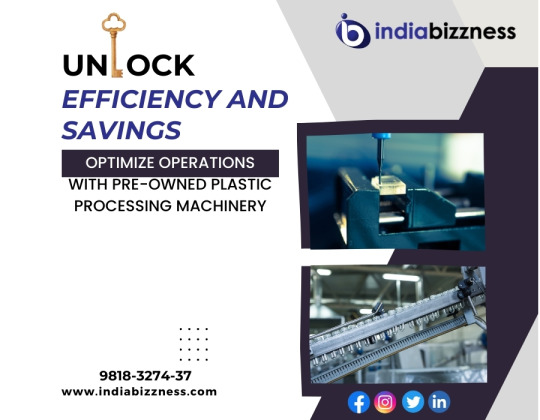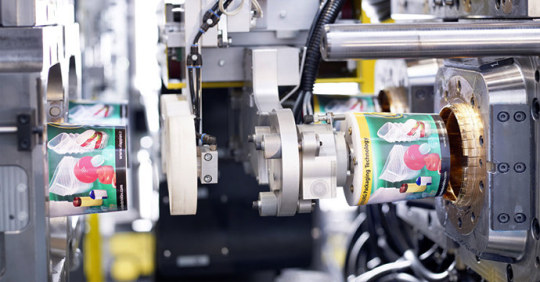#Plastic Injection Process
Text
Plastic Injection: A Fascinating Innovation In Manufacturing
Few methods have transformed the complex world of manufacturing as drastically as plastic injection molding. Plastic injection molding influences everything from the biggest automobile parts to the smallest technological components in ways we might not even be aware of. Come along on an engrossing journey into the depths of this intriguing process as we reveal its uses, applications, and effects…

View On WordPress
#Custom Plastic Injection Molding#Plastic Injection#Plastic Injection Molding#Plastic Injection Process#Plastic Injection Process China
2 notes
·
View notes
Photo

Pressure Molding: Ceresana Report on the European Market for Plastic Injection Molding
From raw material directly to finished part: Injection molding is one of the most important processes in the plastics industry. "3D printing may be faster and does not require expensive molds," says Oliver Kutsch, Ceresana's managing director: "But injection molding is still unbeatable when it comes to cost-effectively producing plastic products of virtually any size or shape in huge quantities." Ceresana has studied the European market for injection-molded plastics: Last year, nearly 12.9 million tonnes of plastics were processed in Europe using this method.
Further information about the new market study “Plastic Injection – Europe”: https://www.ceresana.com/en/market-studies/industry/plastic-injection-europe/
#plastics#injection#molding#Plastic Processing#processing#packaging#producers#production#industry#chemical#manufacturers
2 notes
·
View notes
Text
Mobile phone shell injection mold design and moldflow
1 Preliminary preparation
1.1 Overview
Mobile phone products have huge market development space. At the same time, market is also in a stage of rapid development. This is an extremely important development stage for manufacturers, distributors and retailers, and is a stage where market structure is gradually taking shape. Therefore, in next few decades, design and processing of mobile phone…

View On WordPress
#barrel temperature#Cold material well design#cooling system design#Design of demoulding mechanism#design of mold base#design of molded part#Design of molding parts#design of plastic molded parts#Exhaust system design#Flow analysis#Gate design#Gate location selection#gating system design#Grid connectivity diagnosis#Grid related analysis#Guide mechanism design#injection mold design#injection molding machine#large and medium-sized molds#Mesh thickness diagnosis#mobile phone case injection mold#Mobile phone shell injection mold design#mold design#mold manufacturing#mold manufacturing and assembly#Mold temperature#molded parts of injection mold#Moldflow#molding process#multi-cavity mold
0 notes
Video
youtube
DIY Temperature Controller for Molding Systems | Arduino Tutorial
#youtube#DIY#Arduino Tutorial#Temperature Controller#Molding Systems#Injection Molding#Arduino Nano#Membrane Keypad#LCD#Relay Module#Max6675 Module#Thermocouple#Plastic Molding#Electronics Tutorial#Maker Community#Plastic Injection Molding#Arduino#Hot Nozzle#Molding Process#MAX6675#LCD Display
0 notes
Text

Unlock Savings and Efficiency with Pre-Owned Plastic Processing Machinery
Discover the key to cost-effective production with pre-owned plastic processing machinery. Unlock significant savings and enhance operational efficiency by investing in high-quality, reliable equipment at a fraction of the cost of new machines. From extruders to injection molding machines, IndiaBizzness pre-owned selection offers a range of solutions tailored to meet your manufacturing needs. Maximize your output and minimize expenses with trusted pre-owned machinery.
#Pre-Owned Plastic Processing Machinery#IndiaBizzness#Used injection molding machines#Second Hand extruders Machines
0 notes
Text
#ISBM Mould Injection Machines#Plastics Processing Machinery Australia#Labelling or Decorating Machines
0 notes
Link
Thermoforming VS. Injection Moulding: Which One You Should Choose?
Discover the key factors in the Thermoforming vs. Injection Moulding dilemma with Ridat Company. Uncover the pros and cons, cost considerations, and lead time comparisons for each manufacturing method. Make informed decisions for your unique projects with insights from UK's leading manufacturer of Thermoforming Equipment.
#Thermoforming vs. Injection Moulding#Manufacturing Methods#Plastic Product Manufacturing#Thermoforming Process#Injection Moulding Process
0 notes
Text
#temperature control system#Temperature- control units#Temperature Control Units (TCU)#TEMPERATURE CONTROL UNITS (WATER)#automatic water temperature control systems#temperature control units for injection molding#temperature control module#Temperature Controllers#Products - Temperature control units#injection molding process#plastic regrind machine
0 notes
Video
youtube
Plastic injection molding machines of our factory and other equipment for rainwater harvesting modular tanks
#youtube#rainwater collection#rainwater harvesting#rainwater harvesting system#tank factory#factory tour#factory direct#plastic injection molding#production machine#modular tank#water tank#underground tank#compression testing machine#processing machine#performance testing
0 notes
Text
#cnc machined parts#injection Mold Plastic Manufacturer#cnc Machining Parts#parts for Cnc Router#cnc Parts Online#Plastic Injection Molding#Plastic Molding#Plastic Injection Molding Services#Metal Stamping Parts#Molding Abs Plastic#Abs Plastic Molds#Abs Plastic Injection Molding#Plastic Injection Molding Process#Cnc Machining Precision Components#Cnc Parts Supply#Custom Plastic Parts
0 notes
Text
How to Deal With Engineering Plastics injection molding Material selection?
Engineering Plastics injection molding Material selection is a critical factor in thermoplastics injection molding, as it directly affects the properties and performance of the final product. Here are some important factors to consider when selecting materials for thermoplastics injection molding:
Material properties: The material properties should be matched to the requirements of the final product, including factors such as strength, stiffness, toughness, heat resistance, chemical resistance, and biocompatibility. The material should also be compatible with any secondary processes, such as sterilization or surface treatment.
Engineering Plastics injection molding process characteristics: The material should be compatible with the injection molding process and the specific requirements of the molding equipment, such as melt temperature, viscosity, and mold filling properties. The material should also be capable of being molded consistently and efficiently, with minimal waste or defects.
Cost: The material cost should be considered in relation to the requirements of the final product and any budgetary constraints. While some materials may offer superior properties, they may also be more expensive, and a balance must be struck between performance and cost.
Availability: The material should be readily available from reliable suppliers to ensure a consistent supply chain for production. The availability of the material should also be considered in relation to any potential changes in demand or supply chain disruptions.
Regulatory compliance: The material should comply with any relevant regulatory standards and requirements, such as FDA regulations in the United States or equivalent regulations in other countries. The Engineering Plastics injection molding Material selection should also be tested and certified for biocompatibility if it is intended for use in medical devices.
By considering these factors in Engineering Plastics injection molding Material selection, it is possible to choose a material that meets the requirements of the final product while also being compatible with the injection molding process and the demands of the production environment. It is important to work with experienced professionals in the injection molding industry to ensure that the material is properly selected and tested before production begins.
https://www.inject-mold.com/engineering-plastics-injection-molding-material-selection/
0 notes
Text
#Non-standard precision machining#precision#cnc swiss#precision parts#cnc turning#Precision machining manufacturer#shaft#The main processing methods of metal parts are: machining#stamping#precision casting (investment casting)#powder metallurgy#metal injection molding. Machining refers to the process of changing the dimensions or properties of a workpiece by means of a mechanical d#Stamping is a forming processing method that relies on press and die to exert external force on plate#strip#pipe and profile to produce plastic deformation or separation#so as to obtain the required shape and size of the workpiece (stamping parts). There are also special processing#laser processing#electric discharge processing#ultrasonic processing#electrolytic processing#particle beam processing and ultra-high speed processing. Turning#milling#forging#casting#grinding#CNC machining#CNC center all belong to machining.
0 notes
Text
How Silicone Shot Molding Works
Developing silicone-like components can be done with different procedures, but among one of the most preferred processes is silicone shot molding. This approach produces pliable, durable components that can be used in a variety of applications. Shot molding is a cost-effective means to mass produce silicone items.
Silicone injection molding starts with preparing the raw materials and warming them. A metering pump or a static mixer helps to mix the products as well as provide them uniform. The metering unit additionally drain the driver and also the base forming product, which is then launched right into the mold cavity. This procedure helps to produce a constant blend of materials and makes certain that the proportion of products stays the exact same throughout the molding process.
carbon fibre wing
After the materials are mixed, the mold and mildew is heated up making use of an electrical heater. This assists to preserve the temperature level of the mold and mildew and ensures that the silicone loads the mold and mildew swiftly. The temperature is gotten used to match the style of the component being molded. A gateway as well as jogger system is utilized to guarantee that the silicone fills the mold completely. The pressure is likewise gotten used to match the style of the part.
After the materials have been blended, they are pumped right into the mold. The metering pump is connected to a main pumping system, which provides the fluid silicone rubber with the essential pressure to get in the mold dental caries.
precision cnc machining parts
The mold and mildew is then closed, with a securing force used by the equipment. The device closes in coordination with the injector. This process aids to make certain that the mold dental caries is loaded totally and the product will certainly not be affected by flash. The maker likewise assists to reduce the chances of part contamination. The mold can additionally be recycled for the next molding cycle.

Along with the mold, the shot molding procedure also calls for ejector pins and vents to enable air to get away from the mold and mildew. The mold and mildew can likewise be heated by water flowing inside the mold and mildew. In order to eliminate the opportunity of flashing, the mold and mildew should be furnished with appropriate vents.
Shot molding is an excellent approach for manufacturing top quality, long-term human implants. The procedure is also extremely hygienic and also simple to sanitize. The mold and mildew can likewise be used to produce seals for aerospace applications. This process generates virtually similar items, leading to an extremely affordable per unit after the initial investment in tools.
Another benefit of silicone injection molding is that the process can be carried out in vacuum cleaner problems. This procedure is extremely efficient and produces high result rates. It additionally has very little downtime. The process can be carried out in ISO certified tidy areas, which are extremely sanitary and ecologically managed.
carbon fiber air intake
Along with the mold, the silicone injection molding procedure also needs an automated robot components elimination system. This helps to minimize the opportunity of component contamination, as well as the labor prices associated with hands-on molding procedures. This process likewise assists to lower program expenses as well as supplies part dependability during high-volume runs.
#injection moulding products#injection molded parts#injection parts#plastic injection molding factory#plastic injection molding companies#injection molding processing#plastic injection molding service#plastic moulding company
1 note
·
View note
Text
Design of Injection Mold for Annular Beveled Pipe End Cover
Preface
For tapered pipe plastic parts, common mold structure is to place plastic part to be formed in vertical direction. Core on inner surface of molded plastic part is positioned on movable mold plate and remains stationary. Plastic parts are pushed out from core by pusher plate and ejected from mold. For some plastic parts of inclined tapered pipes with special structures, above mold…

View On WordPress
#cooling system#core-pulling structure design#Design of Injection Mold#gating system#Injection Mold for Annular Beveled Pipe End Cover#mold structure design#Mold working process#molded plastic part#Oblique core-pulling structure design#Plastic part structure analysis#plastic parts#slider structure design#structural design of mold
0 notes
Text

Used Plastic Injection Moulding Machines for Sale
Browse inventory of high-quality, used plastic injection moulding machines for sale. Ensure optimal performance and reliability. With a range of sizes and specifications available, you can find the perfect machine to suit your production needs. Whether you're a small business or a large-scale manufacturer, we offer competitive pricing and exceptional customer service to facilitate a seamless purchasing experience.
#Plastic Injection Moulding Machines#Second Hand Plastic Injection Moulding Machines#Used Plastic Injection Moulding Machines#Sell Used Plastic Injection Moulding Machines#Plastic Injection Moulding Machines for Sale#Buy Used Plastic Injection Moulding Machines#plastic processing machinery
0 notes
Text
Tech Trends: The Latest Innovations in Labelling and Decorating Machines for Plastic Products
In the ever-evolving manufacturing landscape, the labelling and decorating of plastic products have undergone technological revolutions. In this blog, we’ll journey through the most exciting and cutting-edge tech trends, reshaping the world of labelling and decorating machines.

1. Smart Labeling with IoT Integration:
Picture this: your plastic product communicating its journey from the production line to the consumer’s hands. Smart labelling, powered by the Internet of Things (IoT), transforms how we interact with plastic products. These labels, equipped with sensors and data-sharing capabilities, offer real-time insights into a product’s status, location, and environmental conditions. It’s not just about aesthetics anymore; it’s about creating a dynamic, connected experience for manufacturers and consumers.
2. Augmented Reality (AR) in Decorating:
Step into augmented reality, where decorating plastic products becomes an immersive and interactive experience. Imagine customers using their smartphones to unlock hidden AR content in product decorations. AR is injecting an element of playfulness and engagement, turning each plastic item into a canvas for creativity. This tech trend creates consumer excitement and allows brands to tell compelling stories through their products.
3. 3D Printing for Customised Designs:
The era of one-size-fits-all is making way for personalised perfection with 3D printing in decorating machines. Manufacturers can now create intricate and highly customised designs on plastic products, meeting the growing demand for unique and personalised items. This printing not only adds a touch of exclusivity but also reflects the consumer’s individuality in the products they choose. From intricate patterns to personalised branding, 3D printing revolutionises how we decorate plastics.
4. Robotics and Automation for Precision Labelling:
Precision is the game’s name, and robotics are taking centre stage in labelling machines. With advanced robotics and automation, the application of labels on plastic products has reached new levels of accuracy and efficiency. These plastic automation machine systems ensure that you apply each label with the perfect alignment and pressure, enhancing the overall visual appeal of the product. It’s not just about sticking labels; it’s about achieving a flawless and consistent finish every time.
5. Sustainable Labelling Materials:
In the age of heightened environmental consciousness, the materials used for labelling and decorating machines are undergoing a green revolution. Manufacturers are embracing sustainable and eco-friendly labelling materials, ensuring that the aesthetic enhancements do not come at the cost of the planet. From biodegradable labels to water-based inks, the latest trend is to make plastic products visually appealing and environmentally responsible.
6. Nano-Technology for Ultra-Fine Detailing:
Enter the microscopic realm of nano-technology, where labelling and decorating machines push the boundaries of detailing to new extremes. This cutting-edge technology allows for ultra-fine precision in designs, enabling intricate patterns and microscopic textures on plastic surfaces. Nano-decorations elevate the visual appeal and offer a tactile experience, transforming how consumers interact with plastic products. It’s a game-changer for industries seeking to make a bold statement through their products.
7. Machine Learning for Predictive Design Trends:
Combining machine learning and decorating machines is ushering in an era of predictive design trends. These intelligent systems analyse vast datasets to identify emerging design patterns, colour schemes, and consumer preferences. This system allows manufacturers to stay ahead of the curve, creating plastic products with decorations that resonate with current and future trends. It’s not just about what looks good now; it’s about anticipating what will capture hearts and attention.
8. Responsive Ink Technologies:
Say goodbye to static designs and hello to responsive ink technologies. These inks react to external stimuli such as temperature, light, or touch, bringing an element of dynamism to plastic decorations. Imagine a label that changes colour with temperature variations or a product that reveals hidden patterns when exposed to sunlight. Responsive inks add an interactive and dynamic layer to plastic products, turning them into conversation starters and enhancing the overall consumer experience.
9. Digital Watermarking for Authentication:
In the era of counterfeits, digital watermarking is emerging as a game-changing technology for product authentication. Decorating machines now embed digital watermarks within the design, uniquely identifying each plastic product. Consumers can verify the authenticity of their purchases through mobile apps or specialised scanners, ensuring they receive genuine, high-quality products. It’s a technological leap forward in building trust and confidence in the market.
10. Collaborative Design Platforms:
Say hello to collaborative design platforms that bring manufacturers, designers, and consumers together in a virtual space. These platforms leverage the power of the crowd, allowing consumers to participate in the design process of their favourite plastic products. Manufacturers can crowdsource ideas, receive instant feedback, and create products that resonate with the diverse preferences of their target audience. It’s a shift from traditional design processes to a more inclusive and engaging model.
11. Augmented Sustainability:
Labelling and decorating machines are incorporating augmented sustainability features in a world increasingly focused on environmental responsibility. This feature integrates eco-friendly materials, such as recycled or biodegradable substrates, into the labelling and decorating processes. Manufacturers embrace sustainable practices in the end product and throughout the production cycle, ensuring that the aesthetic enhancements align with broader environmental goals. This trend contributes to a greener planet and resonates with eco-conscious consumers seeking responsibly adorned plastic items.
12. Haptic Technology for Tactile Experiences:
Move beyond visual appeal with the integration of haptic technology in decorating machines. This technology enables the creation of tactile experiences on plastic surfaces, adding a sense of touch to the aesthetics. Imagine a plastic product with a textured label that mimics the feel of fabric or a character that provides subtle vibrations in response to user interaction. Haptic technology is revolutionising the sensory dimension of plastic decorations, making them more engaging and memorable for consumers.
Conclusion:
As we bid farewell to this whirlwind tour of tech trends in labelling and decorating machines for plastic products, one thing is crystal clear – the future is both fascinating and sustainable. Intelligent labels, augmented reality, 3D printing, robotics, and eco-friendly materials reshape how we perceive and interact with plastic items. The journey from production to consumer hands is no longer a mere transaction; it’s an immersive, connected, and personalised experience.
#injection moulding machines#injection moulding#blow moulding machine alphamac#blow moulding machines#moulding machine#recycling machine#plastics processing machinery
0 notes